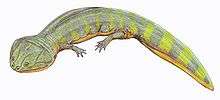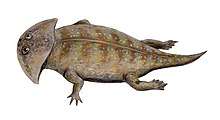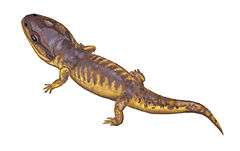Chinlestegophis
Chinlestegophis, a putative Triassic stereospondyl considered to be related to metoposauroids such as Rileymillerus, is an extinct genus of possible stereospondylian and has been noted to share many features with caecilians, a living group of legless burrowing amphibians. If Chinlestegophis is indeed both an advanced stereospondyl and a relative of caecilians, this means that stereospondyls (in the form of caecilians) survived to the present day.[1] However, the original study reported only a Bayesian consensus and a majority-rule consensus tree of the main data matrix, and while both support the claimed caecilian affinities of Chinlestegophis jenkinsi, the strict parsimony consensus tree does not, given that it is compatible with lissamphibian monophyly (indeed, this topology is found in some of the most parsimonious trees).[2]
| Chinlestegophis | |
|---|---|
| Scientific classification | |
| Kingdom: | |
| Phylum: | |
| Order: | |
| Suborder: | |
| Superfamily: | |
| Genus: | †Chinlestegophis Pardo et al., 2017 |
| Binomial name | |
| †Chinlestegophis jenkinsi Pardo et al., 2017 | |
Chinlestegophis jenkinsi, the type and only species, is known from two partial skulls discovered in the Chinle Formation in Colorado.
References
- Pardo, Jason D.; Small, Bryan J.; Huttenlocker, Adam K. (2017-07-03). "Stem caecilian from the Triassic of Colorado sheds light on the origins of Lissamphibia". Proceedings of the National Academy of Sciences. 114 (27): E5389–E5395. doi:10.1073/pnas.1706752114. ISSN 0027-8424. PMC 5502650. PMID 28630337.
- Marjanović, David; Laurin, Michel (2019). "Phylogeny of Paleozoic limbed vertebrates reassessed through revision and expansion of the largest published relevant data matrix". PeerJ. 6 (e5565): 1–191. doi:10.7717/peerj.5565.



